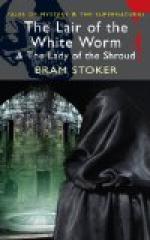“I hope both you young men will keep your heads cool,” put in Mr. Salton. “You know, Adam, it won’t do to have any quarrel between you, especially so soon after his home-coming and your arrival here. We must think of the feelings and happiness of our neighbours; mustn’t we?”
“I hope so, sir. I assure you that, whatever may happen, or even threaten, I shall obey your wishes in this as in all things.”
“Hush!” whispered Sir Nathaniel, who heard the servants in the passage bringing dinner.
After dinner, over the walnuts and the wine, Sir Nathaniel returned to the subject of the local legends.
“It will perhaps be a less dangerous topic for us to discuss than more recent ones.”
“All right, sir,” said Adam heartily. “I think you may depend on me now with regard to any topic. I can even discuss Mr. Caswall. Indeed, I may meet him to-morrow. He is going, as I said, to call at Mercy Farm at three o’clock—but I have an appointment at two.”
“I notice,” said Mr. Salton, “that you do not lose any time.”
The two old men once more looked at each other steadily. Then, lest the mood of his listener should change with delay, Sir Nathaniel began at once:
“I don’t propose to tell you all the legends of Mercia, or even to make a selection of them. It will be better, I think, for our purpose if we consider a few facts—recorded or unrecorded—about this neighbourhood. I think we might begin with Diana’s Grove. It has roots in the different epochs of our history, and each has its special crop of legend. The Druid and the Roman are too far off for matters of detail; but it seems to me the Saxon and the Angles are near enough to yield material for legendary lore. We find that this particular place had another name besides Diana’s Grove. This was manifestly of Roman origin, or of Grecian accepted as Roman. The other is more pregnant of adventure and romance than the Roman name. In Mercian tongue it was ’The Lair of the White Worm.’ This needs a word of explanation at the beginning.
“In the dawn of the language, the word ‘worm’ had a somewhat different meaning from that in use to-day. It was an adaptation of the Anglo-Saxon ‘wyrm,’ meaning a dragon or snake; or from the Gothic ‘waurms,’ a serpent; or the Icelandic ‘ormur,’ or the German ‘wurm.’ We gather that it conveyed originally an idea of size and power, not as now in the diminutive of both these meanings. Here legendary history helps us. We have the well-known legend of the ‘Worm Well’ of Lambton Castle, and that of the ‘Laidly Worm of Spindleston Heugh’ near Bamborough. In both these legends the ‘worm’ was a monster of vast size and power—a veritable dragon or serpent, such as legend attributes to vast fens or quags where there was illimitable room for expansion. A glance at a geological map will show that whatever truth there may have been of the actuality of such monsters in the early geologic periods,




